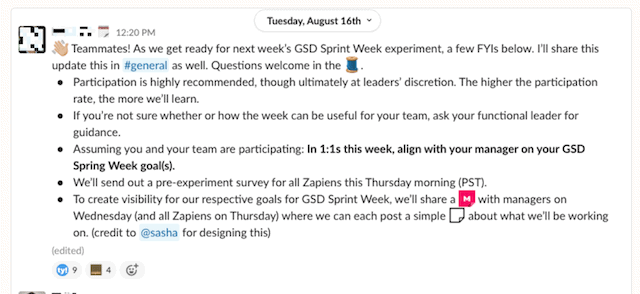Core Concepts
Zapier conducted a week-long experiment canceling all meetings to assess the necessity of real-time collaboration sessions. The core argument is that reducing scheduled meetings can lead to increased productivity and effective communication.
Abstract
Zapier, a fully-remote tech company, experimented with canceling all meetings for a week to evaluate the impact on productivity and communication. Employees found alternative ways to collaborate asynchronously, leading to positive outcomes such as achieving goals and effective communication. The experiment highlighted the importance of reevaluating common workplace practices for optimal efficiency.
Customize Summary
Rewrite with AI
Generate Citations
Translate Source
To Another Language
Generate MindMap
from source content
Visit Source
calnewport.com
What Happened When Zapier Cancelled Meetings for a Week? (Hint: Not Much) - Cal Newport
Stats
80% of respondents would want to do another GSD week in the future.
80% of respondents achieved their goal(s) for the week.
89% of respondents found communication to be about as effective during GSD week as during a typical week.
Quotes
"Our leadership team sent a Slack message giving details about how the week was going to look for the entire company."
"Instead of my weekly 1:1, I consolidated questions for my manager and sent them to her in a direct message on Slack."
"Instead of a project check-in, all team members shared their updates in the relevant Asana tasks."
Key Insights Distilled From
by Study Hacks at calnewport.com 11-21-2022
https://calnewport.com/what-happened-when-zapier-cancelled-meetings-for-a-week-hint-not-much/
Deeper Inquiries
How can other companies implement similar strategies to enhance productivity?
Other companies looking to enhance productivity through strategies like Zapier's GSD week can start by evaluating the necessity of their current meeting structures. By identifying meetings that could be replaced with asynchronous communication methods such as Slack messages, task updates in project management tools, or collaborative document editing, organizations can reduce the time spent in real-time meetings. It is essential for leadership to communicate clearly about the purpose and guidelines of such initiatives to ensure successful implementation. Additionally, conducting post-experiment surveys like Zapier did can help gather feedback and insights for future improvements.
What potential drawbacks could arise from eliminating traditional meetings?
While eliminating traditional meetings may lead to increased productivity and efficiency, there are potential drawbacks that companies should consider. One major concern is the loss of real-time interaction and spontaneous collaboration that face-to-face or virtual meetings provide. Some team members may struggle with feelings of isolation or disconnection if they rely solely on asynchronous communication methods. Moreover, certain complex discussions or decision-making processes might require immediate feedback and discussion which could be challenging without scheduled meetings. Balancing the benefits of reduced meeting times with maintaining effective communication channels is crucial to avoid any negative impacts on teamwork and engagement.
How can asynchronous communication be optimized in remote work environments?
To optimize asynchronous communication in remote work environments, organizations should establish clear guidelines and best practices for using various tools effectively. This includes setting expectations around response times, utilizing project management platforms for tracking progress transparently, and encouraging regular updates through shared documents or messaging apps. Providing training sessions on how to leverage these tools efficiently can also help employees adapt to a more flexible communication style. Additionally, fostering a culture of trust where team members feel empowered to make decisions independently while staying aligned on goals is key to successful asynchronous collaboration in remote settings.
0
